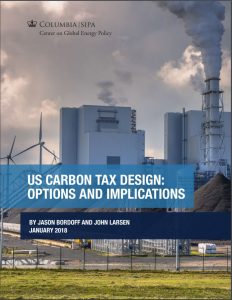Full Title: U.S. Carbon Tax Design: Options and Implications
Author(s): Jason Bordoff & John Larson
Publisher(s): Columbia|SIPA Center on Global Energy Policy
Publication Date: January 1, 2018
Full Text: Download Resource
Description (excerpt):
This initial scoping paper lays out the set of issues to be addressed by identifying the key
design choices to be made in implementing a carbon tax:
- Scope and Emissions Coverage: Determining which sectors and which gases are taxed and what amount of total US greenhouse gas (GHG) emissions would be covered by a tax is critical. The broader the scope, the more efficient and environmentally effective the tax, as it increases the number of GHG abatement opportunities.
- Point of Taxation: Carbon emissions can be taxed upstream, at the point of fuel production, downstream at the point of fuel consumption, or at points in between. An upstream approach taxes emissions from end-use sectors without having to track emissions and tax payments from millions of downstream emitters such as vehicles, factories, and buildings. A downstream approach taxes tons of CO2 that enter the atmosphere at the point where they are emitted. Policymakers must weigh the desired scope of the tax, existing emissions and/or fuel reporting infrastructure, administrative efficiency, and politics in determining where to tax.
- Tax Rate: The combination of the tax rate and the total coverage of the program (as determined by the scope and point of taxation) is what ultimately determines revenue collection, environmental effectiveness, and energy market outcomes. However, there is no guarantee that a carbon tax set at a particular price will guarantee the achievement of a particular emission reduction goal.
- Revenue Allocation Options: Large new sources of federal government revenue are not found frequently, and if a carbon tax is seriously considered, there will be an endless number of stakeholders arguing in favor of their preferred approach. This paper discusses six options for what to do with revenues achieved through a carbon tax, although more than one approach could be chosen. The limiting factor is ultimately the net revenue derived from the tax.
- Interaction between Carbon Taxes and Other Energy/Environmental Policies: Any carbon tax, especially one with an economy-wide scope, will interact with a range of existing energy and environmental policies. Federal regulations, federal research and development on energy technologies, federal subsidies for clean energy, federal royalty, bonus, lease, and tax revenue from fossil fuel production, state regulations, and carbon pricing systems, and state revenue from carbon pricing systems should be taken into account in the design of any tax.
- International Trade Effects and Distributional Considerations: A carbon tax would affect US trade as well as the companies that engage in trade. Policymakers need to discuss how to reduce the risks to US exports that would be subject to a tax when competing against foreign firms not subject to a tax. Work is also needed to understand how a carbon tax would affect households at different income levels, affect different sectors of the economy, and different parts of the country.
